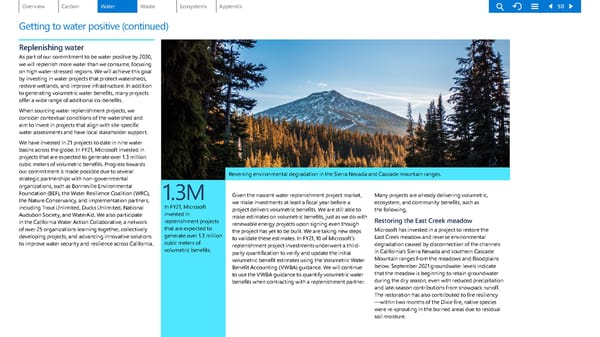50 Getting to water positive (continued) Replenishing water As part of our commitment to be water positive by 2030, we will replenish more water than we consume, focusing on high water-stressed regions. We will achieve this goal by investing in water projects that protect watersheds, restore wetlands, and improve infrastructure. In addition to generating volumetr ic water benefits, many projects offer a wide range of additional co-benefits. When sourcing water rep lenishment projects, we consider contextual conditions of the watershed and aim to invest in project s that align with site-specific water assessments and h ave local stakeholder support. We have invested in 21 proj ects to date in nine water basins across the globe. In FY21, Microsoft invested in projects that are expected to generate over 1.3 million cubic meters of volumetr ic benefits. Progress towards our commitment is made pos sible due to several strategic partnerships with non-governmental organizations, such as Bonneville Environmental Foundation (BEF), the Water Resilience Coalition (WRC), the Nature Conservancy, and implementation partners, including Trout Unlimited, Ducks Unlimited, National Audubon Society, and WaterAid. We also participate in the California Water Action Collaborative, a network of over 25 organizations learning together, collectively developing projects, and advancing innovative solutions to improve water security and resilience across California. Reversing environmental degradation in the Sierra Nevada and Cascade mountain ranges. Reversing environmental degradation in the Sierra Nevada and Cascade mountain ranges. 1.3M In FY21, Microsoft invested in replenishment projects that are expected to generate over 1.3 million cubic meters of volumetric benefits. Given the nascent water r eplenishment project market, we make investments at le ast a fiscal year before a project delivers volumetric benefits. We are still able to make estimates on volumetric benefits, just as we do with renewable energy proj ects upon signing even though the project has yet to be built. We are taking new steps to validate these estimates. In FY21, 10 of Microsoft’s replenishment project investments underwent a third- party quantification to v erify and update the initial volumetric benefit estimates using the Volumetric Water Benefit Accounting (VWBA) guidance. We will continue to use the VWBA guidance to q uantify volumetric water benefits when contract ing with a replenishment partner. Many projects are already delivering volumetric, ecosystem, and community benefits, such as the following. Restoring the East Creek meadow Microsoft has invested in a project to restore the East Creek meadow and reverse environmental degradation caused by disconnection of the channels in California’s Sierra Nevada and southern Cascade Mountain ranges from th e meadows and floodplains below. September 2021 gro undwater levels indicate that the meadow is beginning to retain groundwater during the dry season, even with reduced precipitation and late-season contributions from snowpack runoff. The restoration has als o contributed to fire resiliency —within two months of the Dixie fire, native species were re-sprouting in the b urned areas due to residual soil moisture.
 Environmental Sustainability Report | Microsoft Page 49 Page 51
Environmental Sustainability Report | Microsoft Page 49 Page 51